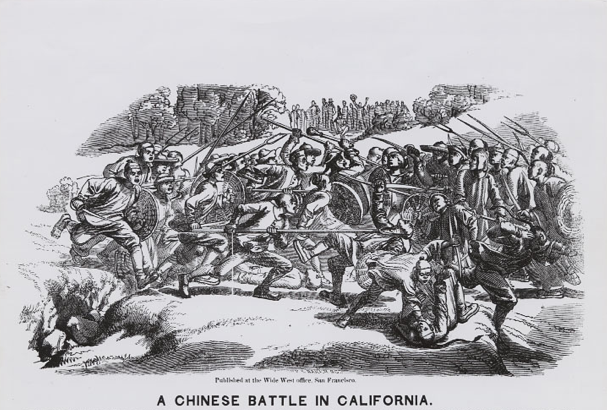This is some fascinating US history that does not get much mention. I had heard about the Tong War in Weaverville when I was fighting forest fires there way back when. But I did not know about the details of this little known war.
Basically this was a classic Chinese battle between two mining companies/gangs in Northern California during the Gold Rush. And boy what a battle? Ironically, only four combatants died in the battle that had 2,500 participants! (the monument says 2000 participated and 26 were killed?)
The one bit of information that really perked me up after reading this article below was the the use of ‘white’ advisers. Here is the quote:
The Sam Yap Company, Hanley wrote, had purchased 150 muskets and bayonets and muskets in San Francisco. They had employed fifteen whites as drill instructors. The instructors were paid ten dollars daily along with all the food and whiskey they could handle.(What cost $10 in 1854 would cost $239.63 in 2010.)
Before the battle the fifteen white mercenaries painted themselves yellow, put on Chinese costumes, and hung a yard of horsehair tail down their backs in a mocking depiction of a Chinese queue.
I would be very interested to know who these fifteen advisers were? At that time period, security contractors were vital to supporting all of the mail and banking activities that came along with the gold rush. The west was a rough place to operate in back then, and hired guns were essential for protecting shipments of gold heading back east or between the various towns of the west. Wells Fargo, American Express, Pinkertons, Butterfield Overland Mail, all started up around this time period. I am sure the Sam Yap Company was able to draw from this pool of security contractors that serviced this industry, to train their forces for this battle.
China was also in the process of modernizing it’s own military and drawing from the military expertise of Europe. So it does not surprise me that these companies would outsource the training of their combatants to insure a win. Which this little tidbit is also pretty cool. Here was the cost of the battle for each side:
After a hundred shots had been fired, the woefully underarmed Yan Wo beat a hasty retreat. Thousands had watched and dueled, but the casualties were light. Sources indicate a death toll of four.
The cost figures were much higher. The Sam Yap Company had expended $40,000 in pursuit of victory, while the Yan Wo Company had spent $20,000 in defeat.
Either way, if you are ever in Northern California and looking for something interesting to do, go visit Weaverville and check out the Joss House. This place has a few of the original weapons that these combatants used. It would have been cool if more of the tactical details of this battle were available, but there really isn’t much out there about it.
I would speculate that if you were to draw from Chinese war fighting tactics of the early 1800’s, that we probably could have drawn some conclusions on how they might have went about fighting this war. But of course these guys were all miners/prospectors and if they had to resort to hiring advisers, and only 4 people died in the battle out of the 2500 that participated, then I have to imagine that it wasn’t that well planned or organized. So no Sun Tzu at this party. lol
Also, I am getting different dates for this war, and have decided to go with what the monument and the Joss House said about the date. So disregard the time period below. –Matt

CHINESE TONG WAR – Near Chinese Camp, October 1856
The historic Gold Country was a violent land — claim jumping, murder, theft, cheating at cards, and much more was quite common.
In October 1856, a different type of violence occurred near Chinese Camp. It was a Chinese Tong War.
A Tong is defined as a Chinese secret society or fraternal organization. While many Tongs were mostly social, some organizations engaged in gang warfare or ethnic revenge.
The Tongs were often rivals for control in the Chinese communities and public challenges toward one another were not unusual. Along the Mother Lode in late Gold Rush California two Tongs were rivals for hegemony. They were the Tuolomne County Sam Yap Company and the Calaveras County Yan Wo Company, headquartered near Chinese Camp.
